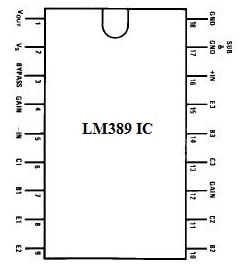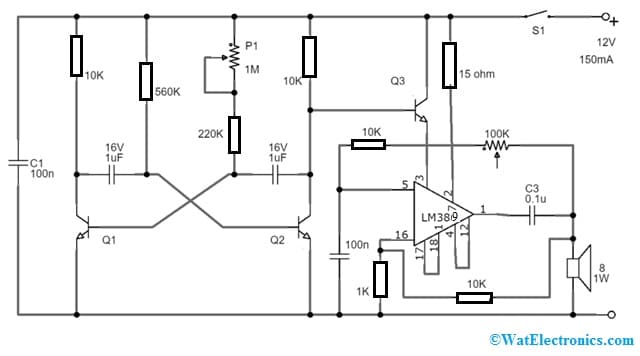The LM (linear monolithic) series ICs originated with National Semiconductor which were the first analog ICs. So, some of them are used still, groundbreaking innovations, and commercially produced. The prefix LM refers to analog components incorporated into a single silicon piece. These are very popular ICs but many of them were second-sourced by different manufacturers with the sequence number for identifying compatible parts. Thus, there are different LM series of ICs that involve op-amps, comparators, audio amplifiers, instrumentation amplifiers, etc. So this article provides an overview of LM389 IC, pin-out, features, specifications & its applications.
What is LM389 IC?
The LM389 is a low-voltage audio power amplifier IC that is utilized to process analog signals like light or sound. The LM389 IC includes an array of three NPN transistors on a similar substrate with an audio power amplifier related to the LM386. Thus, the three transistors in this IC have excellent matching and high gain characteristics. So these are compatible with a wide variety of applications in DC through VHF systems. So the gain of this is set internally at 20 to reduce external parts; however, adding an external capacitor and resistor between pins 4 & 12 will enhance the gain up to a value of 200.
LM389 IC Working Principle
The LM389 low voltage audio power amplifier IC works by controlling, increasing, and amplifying the audio signals’ strength to progress the quality & sound. So the inputs of this amplifier are ground referenced whereas the output is biased automatically to one-half the voltage supplies. The LM389 IC is suitable for different DC applications throughout VHF systems.
LM389 IC Pin Configuration:
The LM389 IC pin configuration is shown below thus, this IC includes 18 pins which are discussed below.

LM389 IC Pin Configuration
- Pin-1 (Vout): An output pin of a low-voltage audio power amplifier IC.
- Pin-2 (Vs): It is a voltage supply pin of IC.
- Pin-3 (Bypass): It is a bypass pin of an IC where a bypass capacitor is connected to an amplifier circuit to let AC signals pass around the emitter resistor. Thus, it increases the amplifier’s AC gain.
- Pin-4 (Gain): This pin is utilized to adjust the gain of the amplifier by connecting this chip to an external capacitor
- Pin-5 (-IN): It is a negative terminal of the amplifier IC.
- Pin-6 (C1): It is a collector terminal of the first transistor in the IC.
- Pin-7 (B1): It is the base terminal of the first transistor of the IC.
- Pin-8 (E1): It is an emitter terminal of the first transistor within the IC.
- Pin-9 (E2): It is an emitter terminal of the second transistor of the IC.
- Pin-10 (B2): It is the base terminal of the second transistor of the IC.
- Pin-11 (C2): It is a collector terminal of the second transistor in the IC.
- Pin-12 (Gain): It is a gain pin of the amplifier IC.
- Pin-13(C3): It is a collector terminal of the third transistor in the IC.
- Pin-14 (B3): It is the base terminal of the third transistor in the IC.
- Pin-15 (E3): It is an emitter terminal of a third transistor within the IC.
- Pin-16 (+IN): It is a positive supply pin of the amplifier IC.
- Pin-17 & 18 (GND): These are GND pins of the IC.
Features & Specifications:
The features and specifications of LM389 IC include the following.
- LM389 is a low-voltage audio power amplifier IC with an NPN transistor array.
- It includes 18 pins and is available in the MSOP package.
- It is battery-operated and uses the least external parts.
- It has a wide voltage supply range.
- Its quiescent current drain is low.
- Voltage gain ranges from 20 to 200.
- It has ground-referenced input.
- It has less distortion and self-centering o/p quiescent voltage
- Its current supply ranges from 1 to 25 mA.
- Frequency ranges from DC to 100 MHz.
- The voltage supply is 15V.
- Its package dissipation is 1.89W.
- Input voltage is ±0.4Volts.
- Storage temperature ranges from -65 to +150 C, thus the operating temperature ranges from 0 to +70.
- The lead temperature is 260 degrees centigrade.
- Collector to emitter voltage or VCEO is 12V.
- Collector to base voltage or VCBO is 15V.
- Collector to substrate voltage VCIO is 15V.
- The collector current or IC is 25 mA.
- The emitter current or IE is 25 mA.
- The base current or IB is 5 mA.
- Power dissipation is 150 mW.
- Thermal resistance JC is 24/W and JA is 70/W.
Equivalents & Alternatives:
LM389 equivalent IC is LM386 IC. Thus an alternative LM389 ICs are; LM1875, LM1876, LM377, LM378, LM379, LM380, LM383, LM2002, LM384, LM1876, LM1875, LM3875, LM3886, etc.
Siren Horn Circuit with LM389 IC
A very powerful siren horn circuit with LM389 IC is shown below. This circuit design is simple but very powerful. So this siren horn circuit is designed with a single LM389 IC and different components like; three BC547 transistors, 1u, 100n, and 47uF capacitors, resistors like 560K, 10K, 1K, 22K, 220K & 15K, a speaker and 100K variable resistor.

Siren Horn Circuit with LM389 IC
Thus, the connections of this siren horn circuit follow as;
- The T1 transistor in the circuit is connected as a CE configuration. So the collector terminal of this transistor is connected to the base terminal of T2 whereas the emitter terminal is connected to the -ve terminal of the supply.
- The T1 transistor’s base terminal is connected to the T2 transistor’s collector terminal through an R1 resistor and P1 potentiometer.
- Here, the T2 Transistor is connected in a CE configuration. So the collector terminal is connected to the T1 base & the emitter terminal is connected to the -ve terminal of the supply.
- The T3 transistor’s base is connected to the T2 transistor’s collector terminal.
- The collector terminal is connected to the +ve terminal of the r supply whereas its emitter is connected to the P2 potentiometer.
- Thus, the LM389 IC can be connected as an audio power amplifier, so the output of this amplifier can be taken from pin-1 & connected to the loudspeaker through a C5 capacitor.
Working
This high-powered LM389 IC siren horn circuit is very simple to design and this IC includes three transistors. So this circuit is designed mainly to form a stable multivibrator that switches or oscillates back and forth between two special states. Thus the frequency of this multivibrator can be adjusted between pins 1 & 7 using a P1 potentiometer and is controlled with two T1 & T2 transistors.
This circuit also includes an audio power amplifier that makes an o/p frequency from 250 Hz to 1500 Hz range. So this frequency can be amplified & played throughout a loudspeaker. This amplifier can also be connected as a squarewave oscillator which produces a square waveform.
The amplifier is controlled by the multivibrator through a T3 transistor which generates a pulsed sound similar to a siren. So the siren’s frequency can be changed to sound at the required frequency with the P2 preset. Thus high-power siren horn circuit with a single IC, loudspeaker, and some components is a very simple device that generates loud siren sounds through the loudspeaker.
Advantages & Disadvantages
The advantages of LM389 IC include the following.
- LM389 IC has an outstanding supply rejection and does not need a fine-regulated supply.
- This IC provides higher i/p impedance, fixed voltage gain, low power drain, and many more.
- These are lightweight, very small with fewer lead wires & solder joints.
- They consume less power, are reliable & have a longer life.
- These are not expensive & very suitable for mass production.
- These ICs are simple to replace.
- This IC has increased operating speed and simplified circuit design.
- It can amplify small input signals without distortion.
The disadvantages of LM389 IC include the following.
- These ICs cannot work at a higher voltage.
- Generally, these are fragile.
- They cannot resist a higher voltage operation.
- This IC has a limited power rating.
- They consume full power irrespective of the signal amplitude.
- These amplifiers frequently have second harmonic distortion.
- They generate clicks & pops whenever turning ON or OFF.
- They experience issues such as distorted sound, no sound, low output, overheating, buzzing, or humming.
- SNR must be a minimum of 90 dB mainly for low-power amplifiers to keep away from audible hiss, 100 dB mainly for medium-power amplifiers & 110 dB mainly for high-power amplifiers.
Applications
The applications of LM389 IC include the following.
- Audio amplifier IC is used to enhance the sound quality of an audio signal.
- This amplifier IC is used in computers, microprocessors, computer networks, digital signal processors, frequency counters, etc
- These ICs are used in different systems like karaoke players, car audio, headphones, flat screen monitors, musical toys, instruments, home entertainment, portable and wireless speakers, etc.
- It is used in sensors, image processing, computing devices, and AI functionality.
- This amplifier IC is a primary part of all microelectronics designs for autonomous vehicles, healthcare, defense, space, etc.
- This IC is used in AM radios, FM radios, phonographs, tape recorders, etc.
- This IC can be used in different applications like alarms, emergency vehicles, security, consumer electronics, automotive, telecommunications & industrial.
- This is a significant amplifier IC, so it performs different functions like oscillator, amplifier, timer, counter, computer memory, logic gate, microprocessor, microcontroller, etc.
Please refer to this link for the LM389 IC Datasheet.
Thus, this is an overview of LM389 IC, pinout, features, specifications, circuit, working, and its applications. So this is a low-voltage audio power amplifier IC that is utilized to pre-amplify, match, and combine audio signals from different sources like CD players, digital audio players, record players, etc. Thus, this amplifier’s output ranges from a few watts to thousands of watts used for large sound systems. Here is a question for you, what is LM383 IC?